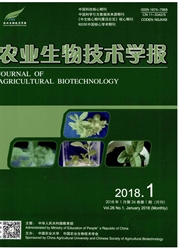

 中文摘要:
中文摘要:
构建植物病原菌突变体库是进行新基因发掘和功能基因组学研究的有效途径之一。为快速准确地鉴定Tn5的插入位点和相应的功能基因,研究采用热不对称PCR(TAIL-PCR)和Tn5转座子质粒拯救两种技术,鉴别了在筛选水稻条斑病菌(Xanthomonas oryzaepv.oryzicola)Tn5插入突变体库过程中获得的8个在水稻(Oryza sativa)上毒性减弱的突变体。结果显示,TAIL-PCR和Tn5质粒拯救结合使用,可有效地鉴别Tn5的插入位点和相应的功能基因。TAIL-PCR鉴别的5株突变体是Tn5分别插入在分泌系统结构蛋白F基因(gspF)、cAMP调控蛋白、膜镶嵌蛋白酶酶原、S-蛋硫氨酸脱羧酶亚基和gspJ基因上;Tn5质粒拯救法鉴别的3株突变体是Tn5分别插入在致病性蛋白、功能未知的保守蛋白和鞭毛特异性ATP合酶基因上。序列同源性分析发现,8株突变体Tn5插入的基因与基因组测序的BLS256菌株中的对应基因同一性达100%。这表明,TAIL-PCR和Tn5质粒拯救技术可有效地应用于植物病原菌Tn5突变体库的鉴别和目标基因的分离。
 英文摘要:
英文摘要:
Construction of a mutant library is a fundamental approach for new genes and functional genomics of a plant pathogen. To rapidly and accurately identify a Tn5 insertion position in a corresponding gene in Xanthomonas oryzae pv. oryzicola and the critical pathogen of bacterial leaf streak in rice (Oryza sativa), thermal asymmetric interlaced PCR (TAIL-PCR) and Tn5 transposon rescue were adopted to verify 8 virulence-reduced mutants screened from the Tn5 inserted library of the pathogen based on virulence assay in rice. TAIL-PCR revealed that 5 virulence-reduced mutants were due to the Tn5 transposon which was inserted in the general secretion protein F (gspF), cAMP-regulatory protein, integral membrane protease subunit, S-adenosylmethionine decarboxylase proenzyme, and gspJ genes, respectively. Tn5 transposon rescue indicated that the genes in other three mutants inserted by Tn5 were pathogenicity protein, conserved hypothetical protein, and flagellum-specific ATP synthase genes, respectively. Homology analysis demonstrated that eight genes inserted by Tn5 were 100% identities to the corresponding genes in the genome sequence of the strain BLS256. The results above suggest that TAIL-PCR and Tn5 transposon rescue are effective tools for identifying Tn5 insertion position of a target gene of a plant pathogen and for isolating the target.
 同期刊论文项目
同期刊论文项目
 同项目期刊论文
同项目期刊论文
 期刊信息
期刊信息
